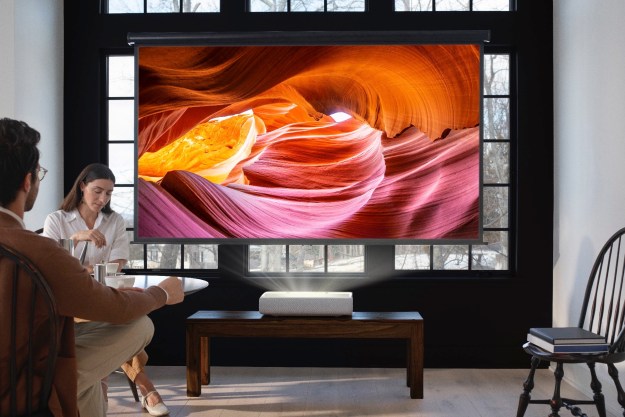AV receivers might be the nerve center of every serious home theater setup, but these big (and usually shiny and black) boxes aren’t exactly the most beautiful things to look at. However, Marantz’s new Cinema line of 8K Dolby Atmos AV receivers might just be the first to give folks a real alternative to the flat-panel-full-of-buttons aesthetic we’ve become accustomed to. The new models start at $1,200 for the Cinema 70s and go up to $7,000 for the flagship AV 10. They will be available by the end of October, though only the Cinema 50 and 60 will be released initially.
In addition to a textured finish that graces the side portions of the Cinema’s front panels, each model has an elegant circular display window that either acts on its own as the main way to see critical status information or can be used to augment a much larger full display hidden behind a hinged cover. It’s a design that Marantz debuted on its Model 30 stereo amplifier. These improvements are more than superficial. The Cinema series also has a new graphical user interface, as well as voice command compatibility.
Here’s the full Cinema range.
Marantz AV 10
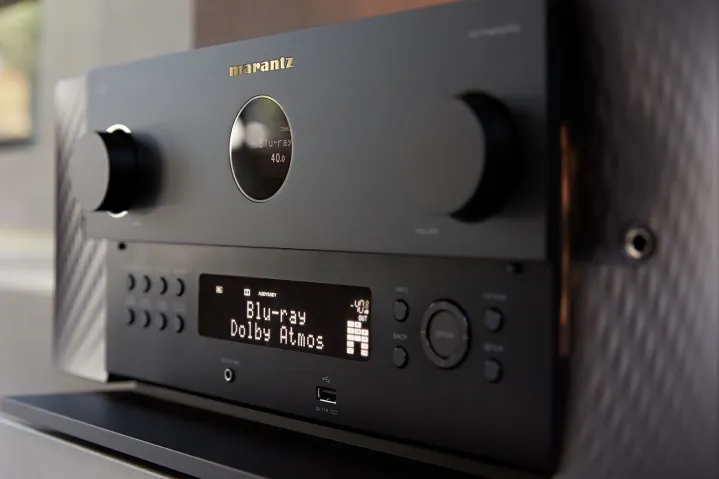
The flagship of the line is a 15.4-channel beast, but unlike the rest of the Cinema series, it’s a preamplifier, which means you’ll need a full-fledged, dedicated amp to drive sound to your speakers. But we’re guessing that if you have the kind of home theater set up that would benefit from the AV 10’s capabilities, you won’t mind splurging an additional $7,000 for the Marantz Amp 10, the 15.4-channel amplifier that has been designed to be the perfect companion to the AV 10.
- $7,000
- HDMI 2.1, HDCP 2.3
- Seven HDMI inputs with full 8K/60Hz and 4K/120Hz support
- Two HDMI outputs with full 8K/60Hz and 4K/120Hz support, one HDMI output with 4K/120Hz
- HDMI ARC/eARC
- Phono input
- Dolby Atmos, DTS:X, IMAX Enhanced, Auro 3D
- HDR / HLG / Dolby Vision / HDR10+ / Dynamic HDR
- Audyssey room tuning
- Wi-Fi, Bluetooth, Ethernet
- AirPlay 2
- Alexa / Google Voice Assistant / Apple HomeKit compatible
- HEOS compatible
- Unbalanced and balanced outputs for each channel
- Multizone capable
- Remote app compatible
Marantz Cinema 40
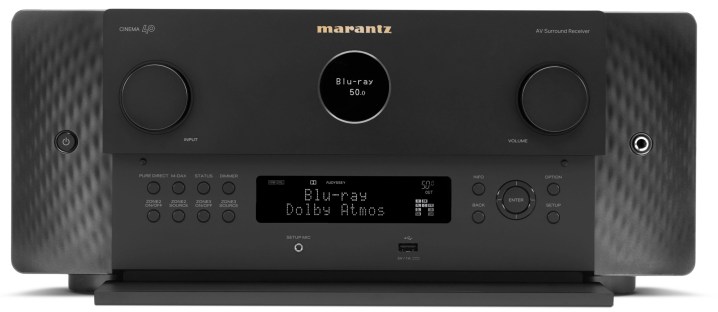
- $3,500
- HDMI 2.1, HDCP 2.3
- 11.4-channel (9 powered channels)
- 125 watts per channel
- Seven HDMI inputs with full 8K/60Hz and 4K/120Hz support
- Two HDMI outputs with full 8K/60Hz and 4K/120Hz support, one HDMI output with 4K/120Hz
- HDMI ARC/eARC
- Phono input
- Dolby Atmos, DTS:X, IMAX Enhanced, Auro 3D
- HDR / HLG / Dolby Vision / HDR10+ / Dynamic HDR
- Audyssey room tuning
- Wi-Fi, Bluetooth, Ethernet
- AirPlay 2
- Alexa / Google Voice Assistant / Apple HomeKit compatible
- HEOS compatible
- Multizone capable
- Remote app compatible
Marantz Cinema 50
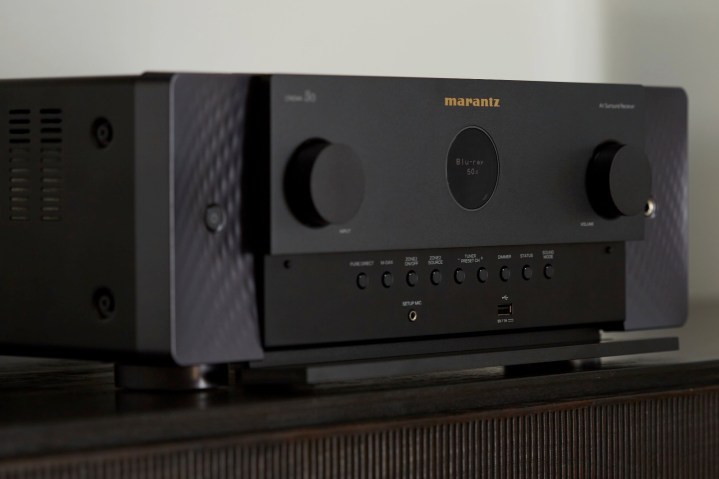
- $2,500
- HDMI 2.1, HDCP 2.3
- 11.4-channel (9 powered channels)
- 110 watts per channel
- Six HDMI inputs with full 8K/60Hz and 4K/120Hz support
- Two HDMI outputs with full 8K/60Hz and 4K/120Hz support, one HDMI output with 4K/120Hz
- HDMI ARC/eARC
- Phono input
- Dolby Atmos, DTS:X, IMAX Enhanced, Auro 3D
- HDR / HLG / Dolby Vision / HDR10+ / Dynamic HDR
- Audyssey room tuning
- Wi-Fi, Bluetooth, Ethernet
- AirPlay 2
- Alexa / Google Voice Assistant / Apple HomeKit compatible
- HEOS compatible
- Multizone capable
- Remote app compatible
Marantz Cinema 60

- $2,500
- HDMI 2.1, HDCP 2.3
- 7.2-channel
- 100 watts per channel
- Three HDMI inputs with full 8K/60Hz and 4K/120Hz support, three HDMI inputs with 4K/120Hz support
- Two HDMI outputs with full 8K/60Hz and 4K/120Hz support, one HDMI output with 4K/120Hz
- HDMI ARC/eARC
- Phono input
- Dolby Atmos, DTS:X
- HDR / HLG / Dolby Vision / HDR10+ / Dynamic HDR
- Audyssey room tuning
- Wi-Fi, Bluetooth, Ethernet
- AirPlay 2
- Alexa / Google Voice Assistant / Apple HomeKit compatible
- HEOS compatible
- Multizone capable
- Remote app compatible
Marantz Cinema 70s
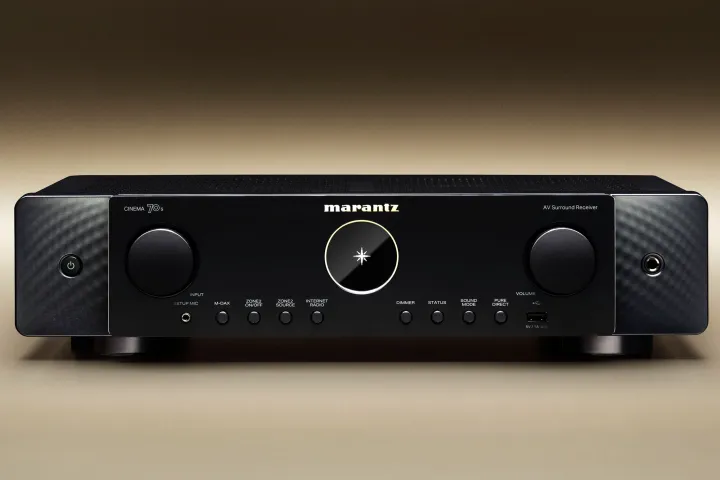
- $1,200
- Ultra-slim design
- HDMI 2.1, HDCP 2.3
- 7.2-channel
- 50 watts per channel
- Three HDMI inputs with full 8K/60Hz and 4K/120Hz support
- Three HDMI inputs with 4K/120Hz support, one HDMI output with 8K/60Hz and 4K/120Hz support
- HDMI ARC/eARC
- Phono input
- Dolby Atmos, DTS:X
- HDR / HLG / Dolby Vision / HDR10+ / Dynamic HDR
- Audyssey room tuning
- Wi-Fi, Bluetooth, Ethernet
- AirPlay 2
- Alexa / Google Voice Assistant / Apple HomeKit compatible
- HEOS compatible
- Multizone capable
- Remote app compatible
Editors' Recommendations
- Samsung QN900D 8K TV first look: fully loaded flagship
- Samsung’s biggest Neo QLED 8K TV comes with an equally huge price
- Denon AVR-X6800H: 8K everywhere and Dirac Live compatibility
- McIntosh’s new $8,000 AVR: gigantic power, with a Dolby Atmos catch
- Is 8K TV dying? It’s not looking good at CES 2023


